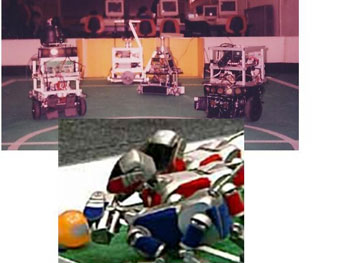
This issue in pdf Archive: Next issue: Next Special theme: |
|
|||
Cognitive Soccer Robotsby Alessandro Farinelli, Giorgio Grisetti, Luca Iocchi and Daniele Nardi The effective development of a system consisting of autonomous heterogeneous robots that have to perform complex tasks over long periods of time, operating in a partially known and partially observable environment, implies addressing a wide range of issues. These issues involve many areas of Artificial Intelligence, from computer vision to deductive systems. Since 1998 we have been developing autonomous robotic systems that have been used within the RoboCup competitions. RoboCup is an organization that promotes research in the field of autonomous robotics by organizing annual world competitions of soccer-player robots. Such competitions are made within different leagues depending on the type and size of the robots. We have created two robot teams: SPQR-Wheeled and SPQR-Legged belonging to different leagues, and although the robots composing the teams are quite different (various kinds of wheeled robots sized about 50x50 cm for the Wheeled team, and Sony AIBO four legged robots for the Legged one), they share the same cognitive system.
The main features required for the design and the implementation of a team of cognitive robots are: (i) a framework for defining the robots' knowledge of the environment and its capabilities; (ii) a reasoning system able to derive plans (ie programs) that must be executed to achieve a given goal; (iii) a plan execution mechanism; (iv) a coordination module that is in charge of assigning sub tasks to each robot in the team in order to achieve a global team goal. Architecture Domain and Plan Representation Plans are represented as transition graphs, whose nodes represent epistemic states and whose edges represent actions causing state transitions. The graph representing a plan has an initial node from which the execution starts and a set of final states in which the goal is satisfied. The execution of an ordinary action causes a deterministic state transition, while the execution of a sensing action causes a state transition depending on the sensing outcome. Moreover, since in the real world the execution of an action is not guaranteed to succeed, a set of recovery states are associated with each action. Plan Generation and Execution A plan is executed by navigating the plan graph, starting from the initial node and terminating when a goal node is reached or when the plan fails. A plan failure can be caused by the failure of some of the execution conditions of the action, and will activate a plan recovery or a new plan selection depending on the presence of edges exiting from the recovery state. Coordination Links:
Please contact: |
|||


